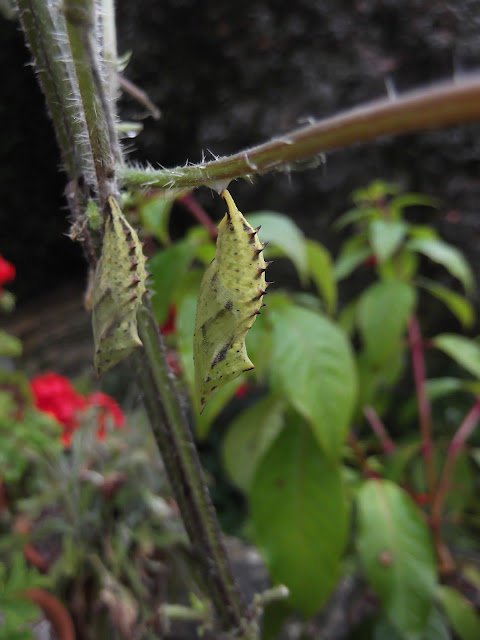
It’s a rummy state of affairs; but it strikes me that one of the best garden plants for butterflies is Urtica dioica, the stinging nettle. This dreadful plant is what our most common butterflies feed on during the caterpillar stage of their life cycle. Comma, Small Tortoiseshell, Red Admiral and Peacock butterflies are the most regular visitors to our green shores, and all lay their eggs on nettles! Without this wretched weed these beautiful creatures would never get to enjoy our buddleia bushes or clumps of sedum, as the caterpillars would starve and die. Unfortunately, as a garden guest the stinging nettle is rather lairy. It will attack if you dare to get near it, and bustle about the place, elbowing its way into areas where there is simply no call for it. Aside from a pleasant flush of fresh green growth in early-summer, the plant spends most of the year as a decrepit wreck looking haggard and ill. The stems get leggy; the lower leaves die off, and inevitably the whole plant is teeming with blasted aphids! This is all rather distressing, particularly as some other caterpillar food plants can be worked into the borders with the utmost ease. Honesty, Devil’s-Bit Scabious, Honeysuckle and Nasturtium are all handsome plants that can be enjoyed to great advantage in the mixed border. Those such as Bird’s-foot Trefoil, Lady’s Smock, native grasses and Sorrel look delightful in the meadow. So where the blazes do the nettles fit in?

Speaking for myself, I believe meadows or rough grass areas are the ideal setting for stands of nettle. Here their raggedy appearance is less of an issue, and it lumps the wild, informal elements together in one safe place. These nettles can be contained within large pots, sunk into the ground, with several inches showing as a lip above the soil surface to prevent those runners creeping along and spreading about. The soil in the pot should be rich and fertile, as the nettle enjoys, in sharp contrast to the deprived soil of the meadow in which any self-seeded nettles will be less vigorous. If the female butterfly is to be coaxed into laying the position must be sunny and sheltered. She is a fussy so-and-so, and a shaded nettle patch behind the shed just simply isn’t agreeable to her! Last year the only caterpillars I spotted were those feeding on my nettle patch near to the bee hives. This is the only patch within the garden that receives full sun for the majority of the day, and interestingly was at that time little more than 3 ft². Clearly a small patch is entirely suitable, so long as the position receives plenty of sun. Fresh shoots are also required by the laying female, so in early June one third of the nettle patch must be cut down. This is repeated a month later and then again in August. There is a danger during these months of removing growth containing eggs, caterpillars or pupae. A visual check of each leaf is required, but this can be jolly rough going over a large nettle patch! I found leaving the trimmings in situ where they fell to be a suitable solution, given that both caterpillars and young butterflies are quite capable of clambering their way back on to the remaining nettles.
 |
| Over a large nettle patch, the quickest method of spotting caterpillars is to look out for their droppings! |
 |
| The caterpillars create these fantastic tents for themselves, with a web to hold the whole thing together. Quite magnificent |
Frankly, we’ve just got to keep these beautiful butterflies going, whatever the cost. I can vouch for there being some young whippersnappers out there trying to influence the way large organisations such as the National Trust utilise their land, as you do need a bit of room to start introducing managed patches of nettles. But if those with room enough can do a bit in their own gardens too, then we can perhaps start reversing the decline in habitat that has blighted the countryside for the past few decades. The sight of butterflies on the wing is so utterly glorious, that it is worth suffering the sight of an ugly nettle or two!






































